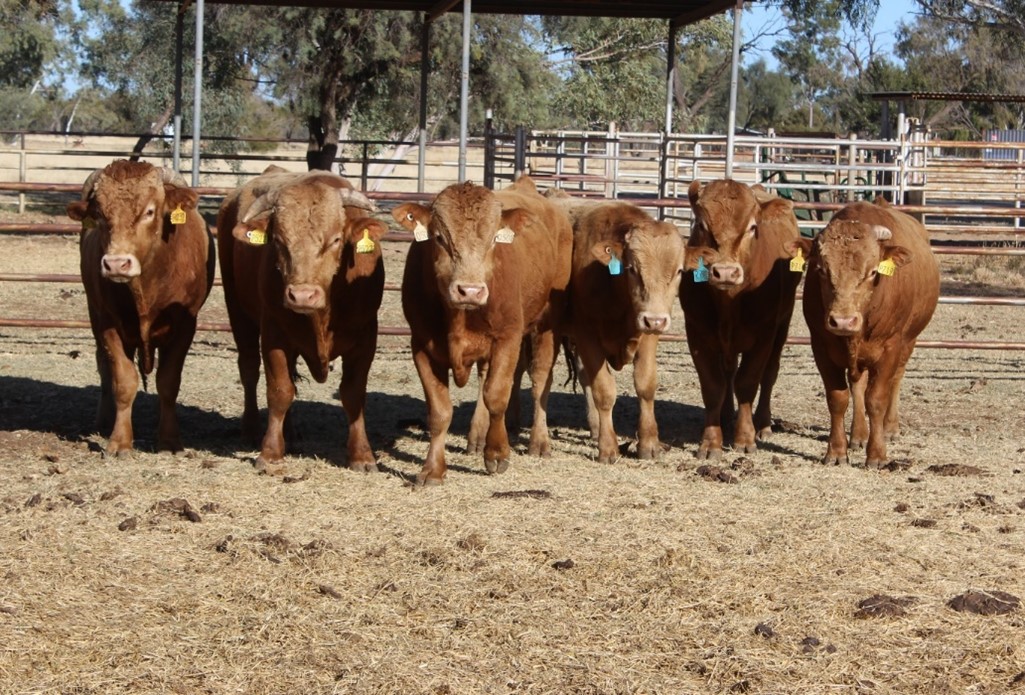Quality Graze project charges ahead with Akaushi Bulls
Six Akaushi bulls are bringing a renewed focus to the long running Quality Graze project on the Department of Industry, Tourism and Trade’s Old Man Plains Research Station (OMP) located 20km south of Alice Springs.
The department’s Quality Graze project has shown that using appropriate grazing land management practises and optimal long-term stocking rates allows producers in Central Australia to turn off consistent numbers of steers for the premium beef market regardless of season. In addition, pre-trucking management of MSA steers (e.g. low stress stock handling, allowing time and space for socialisation) has also helped to improve carcase quality of the steer turnoff from OMP.
In 2014, the project incorporated steers from seven local producers to compare the performance of different breeds under the same conditions. The Steer Challenge showed that under recommended grazing practices, there was no difference in the growth of Shorthorn, Santa Gertrudis, Hereford, Murray Grey, Angus or Droughtmaster cattle. However, towards the end of the project, it looked as though there could be some difference in fat development, suggesting that there could be some advantages in using higher marbling genetics.
Akaushi origins
The Akaushi is sometimes known as the Red Wagyu, or Japanese Brown, and it is similar to the more commonly known Black Wagyu. Both breeds originate from the Japanese draught animal however the Akaushi developed in southern Japan with influences from British Devon, Swiss Simmental and Korean Hanwoo breeds whereas the Black Wagyu developed in south-western Japan with Swiss Brown, Simmental, Ayrshire, Devon, Shorthorn and Holstein influences.
The Akaushi is renowned for high fertility and good beef quality, particularly marbling and eye muscle area. The breed also has several characteristics that allow the animals to handle high heat levels better than most B. taurus breeds.
Marketing expectations
The department’s project leader, Chris Materne, said the team is looking for constant improvements through research to assist industry position for changing markets and production conditions.
“We are looking for an edge on the market right now. This year, the department turned off 161 Droughtmaster steers and 96 per cent of them graded MSA/Grassland Pasturefed (avg. 302.6kg dressed weight @ $8.78/kg).
“We’ve achieved similar results every year for a while now and we want to do even better!”
It is hoped that the Akaushi will add that next level of meat quality so that steers can be graded into a higher boning group. The higher fat content in Akaushi meat contributes to making the beef very tender compared to other breeds.
In addition, there is potential to access the lucrative American HeartBrand premium beef market which promotes Akaushi beef as a healthier red meat option. Akaushi meat has a higher proportion of monounsaturated fats relative to saturated fats which are often considered healthier for human consumption. Akaushi meat contains oleic acid, which is also thought to have some health benefits in reducing cardiovascular disease.

The CY O’Connor Foundation WA are promotors of the Akaushi breed in Australia. The Foundation approached the department after seeing the steer performance in the Quality Graze trial and provided the opportunity to see if it is possible to produce grass-fed, marbled beef in this district. The Akaushi bulls have come from Melaleuka Stud in Western Australia. Foundation Deputy Chairman, Alan Peggs, said he is really looking forward to seeing how the bulls perform in Central Australia.
“We were really impressed by the results coming out of the Quality Graze project. Even when it’s been really dry they have still been producing good numbers of premium steers,” he said.
“We have very high hopes for Droughtmaster cross steers and believe there will be a significant improvement in eating quality with little to no loss of weight gain through the finishing process.
“We hope that the Quality Graze project will be another exciting chapter in the effort to allow production of high quality, marbled beef in the north of Western Australia and Central Australia,” he said.
Local producers are also really interested to seeing what the breed has to offer with several properties already expressing interest in being a part of the trial themselves. The project has the support of the Alice Springs Pastoral Industry Advisory Committee (ASPIAC).
Results a little way off
The bulls arrived in Alice Springs at the end of July where they undertook quarantine and disease testing. They will join the main breeding herd at the department’s OMP site in December 2022.
On OMP, a three month controlled mating period allows for efficient weaning, feeding and marketing of cattle. Calving is timed to occur between September and the end of November to avoid the extreme heat of Central Australian summers. This means that the first group of F1 calves will be weaned in March 2024 and the second cohort in March 2025.
Steers from these groups will be grown out with the Droughtmaster steers before trucking to abattoirs in 2026 and 2027. In the meantime there will be interesting comparisons of liveweight gain in males, mortality in bulls and progeny, and observations of breeder performance.
For now, the bulls are settling in well and everyone at the department has been really impressed with their quiet temperament.
“Getting the grazing land management right is the first step towards producing premium quality steers,’ said Chris Materne.
“We are really looking forward to seeing what the Akaushi can add to the Quality Graze project and to herds in Central Australia.”
Written by Alison Kain, Pastoral Production Officer, NT Department of Industry, Tourism and Trade.